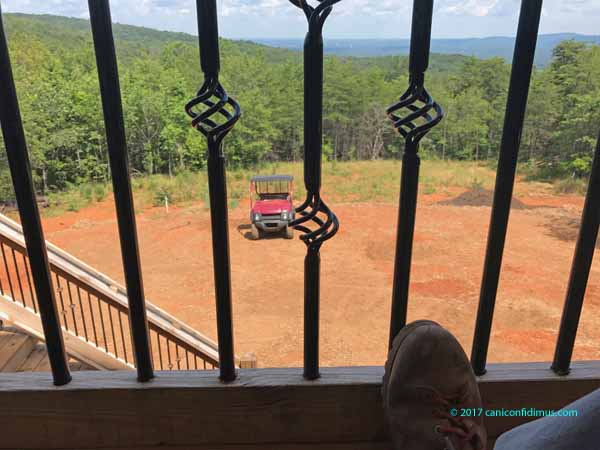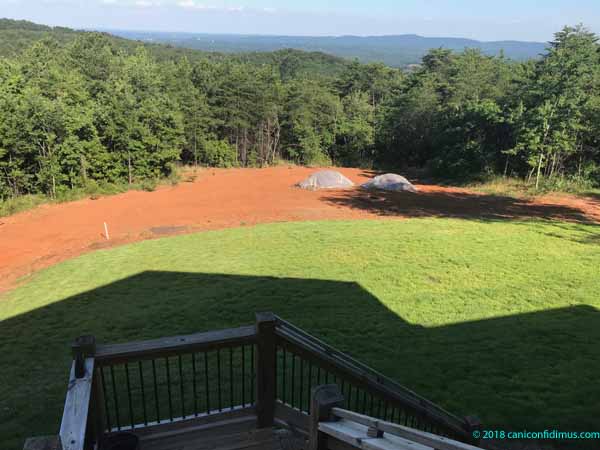Last summer I managed to get part of our front yard prepared and seeded with grass. By the end of the summer we had a partially green front yard. I am now working on the rest of the front yard, and it’s a hard slog.
This is what the prepared yard looked like last year. I used this image in a post when I was working on it.

You can see a few spots where I had to spread some dirt to fill in the gullies washed by a year’s worth of rain, but the rest is generally the way it was when I started the process. Behind the Mule is the area where I’m working now. It was not graded smooth and a lot of weeds and small trees had sprouted. It was even worse this year.
I started early in the spring by burning as much of the growth as I could. Then I sprayed glyphosate several times to kill as much as I could. When most of the green had turned brown, I started skimming the surface and digging some out by the roots with a shovel. This was a long, arduous process that could have been done in a day by a piece of machinery.
Once all of that was done, the front part of the yard was bare but very rough and uneven. I don’t particularly care whether it has a nice, smooth, rounded profile, but it needs to be even so the lawn mower doesn’t dip and scalp the grass. So I made this. This is a combination scarifier-grader. It’s an eight-foot, pressure treated 6X6 and an eight-foot 2X6. I cut both in half. I drove 10 8-inch spikes through the front 6X6 and turned the second 6X6 45 degrees. Then I put two big eye-bolts through the front part and attached the rig to the Mule with a chain. Then I dragged it around in circles for a while.
This is a combination scarifier-grader. It’s an eight-foot, pressure treated 6X6 and an eight-foot 2X6. I cut both in half. I drove 10 8-inch spikes through the front 6X6 and turned the second 6X6 45 degrees. Then I put two big eye-bolts through the front part and attached the rig to the Mule with a chain. Then I dragged it around in circles for a while.
What I hoped would happen is that the spikes, which protrude about two and a half inches, would break up the surface soil, and then the second 6X6 would spread it out evenly, hopefully filling in low points. What I feared is that the spikes would either bend or be driven back up, and that the ground would be so hard the spikes would barely scratch the surface. In the end, it was a little of both. The spikes bent a little but stayed in place, and in some places they barely scratched the surface. But overall, it did what I wanted.

It’s hard to tell from this photo, but the front part of the yard is rolling but pretty smooth. There are a few places that have hard dirt but most of the area has a couple of inches of find, ground-up dirt that should work well when I till in about three inches of topsoil, which is now stored in the two piles you can see. There are also a few low spots I need to fill, but not too many.
So, my home-made grader worked out well. Now all I have to do is spread the topsoil using the trusty Mule and a shovel, till it, spread fertilizer, sow seed, roll it, sprinkle it, and hope for the best.
Of course I’m simplifying this account, because there is an area to the side of the house that I still have to work on. I won’t be able to use my scarifier-grader because the slope is too great, so I’ll have to do that part entirely by hand. But I’m going to finish the front of the yard first so it will have a chance to germinate.
Oh, and we need rain.